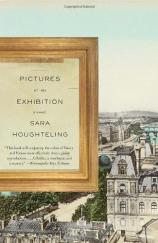Reading Group Guide
Discussion Questions
Pictures at an Exhibition

1. What does Houghteling signal with her epigraph?
2. Now that you’ve finished the novel, reread the first paragraph. What does Max mean about “the violence that would strike us later”? What does each memory signify?
3. How does Goethe’s Theory of Colors (page 5) apply to the Berenzon family itself? And to Rose?
4. Discuss the relationship between Max and Daniel. Why doesn’t Daniel want Max to inherit the gallery? Why did Daniel make Max rehearse the art of recollection?
5. How do you think Daniel intended to finish the sentence, “Over the years I have wanted to tell you—”(page 7)?
6. Reread the passage beginning on page 8, about Manet’s Almonds. What do you think of Max’s insights?
7. On page 43, Max’s mother discusses Mussorgsky’s Pictures at an Exhibition. What are the parallels between the Mussorgsky/Hartmann story and that of Max and Rose?
8. Rose says Max is “too kind, too full of humility” (page 49), while Bertrand compares Max to Baudelaire’s flâneur (page 66). Whose assessment is more accurate?
9. Why does Rose reject Max, telling him that she does not expect to marry?
10. What are Bertrand’s two secrets?
11. Why do you think the novel jumps from 1940 to 1944?
12. “Hope is the devil wearing a new coat” (page 86). What does the concierge mean by that? How does that belief apply throughout the novel?
13. Why does Daniel insist that Max return the Manet sketch? Is it the same reason he refuses to buy back his paintings from the Americans?
14. Discuss Daniel’s curse to the Americans on page 96, and Max’s interpretation of it.
15. On page 115, Max says, “I could not shake the feeling that [Daniel and Rose] each wanted me to find something in my search for Father’s paintings that was different from what I in fact was seeking.” Was Max correct about this? Why, or why not?
16. Reread the conversation between Max and Chaim on page 119. What is Chaim’s role in the novel, and how would you describe his relationship with Max?
17. What is the significance of Rose’s cutting of her hair?
18. On page 144, Max describes Rose’s apartment as “museum and mausoleum in one.” What does he mean by that? What does it say about Rose?
19. Discuss the scene in Cailleux’s gallery, in which Max learns about Micheline.
20. Why does Max go back to medical school?
21. Why does Max convince the man in the yellow shoes to buy the Rosa Bonheur in the flea market?
22. Discuss Max and Rose’s good-bye scene on pages 215–16.
23. Why does Rose buy the Manet for Max?
24. Reread and discuss the last paragraph of the novel.
25. Did you read the author’s note? Does knowing that Rose is based on a real woman change your appreciation for the novel in any way?
SUGGESTED READING
Theory of Colors by Johann Wolfgang von Goethe; The Lady of Shalott by Alfred Lord Tennyson; The Rape of Europa by Lynn Nicholas; Art as Politics in the Third Reich by Jonathan Petropoulos; The Lost Museum by Hector Feliciano; Atonement by Ian McEwan; The Zookeeper’s Wife by Diane Ackerman; The Yiddish Policemen’s Union by Michael Chabon.
Pictures at an Exhibition
- Publication Date: February 9, 2010
- Paperback: 256 pages
- Publisher: Vintage
- ISBN-10: 0307386309
- ISBN-13: 9780307386304







